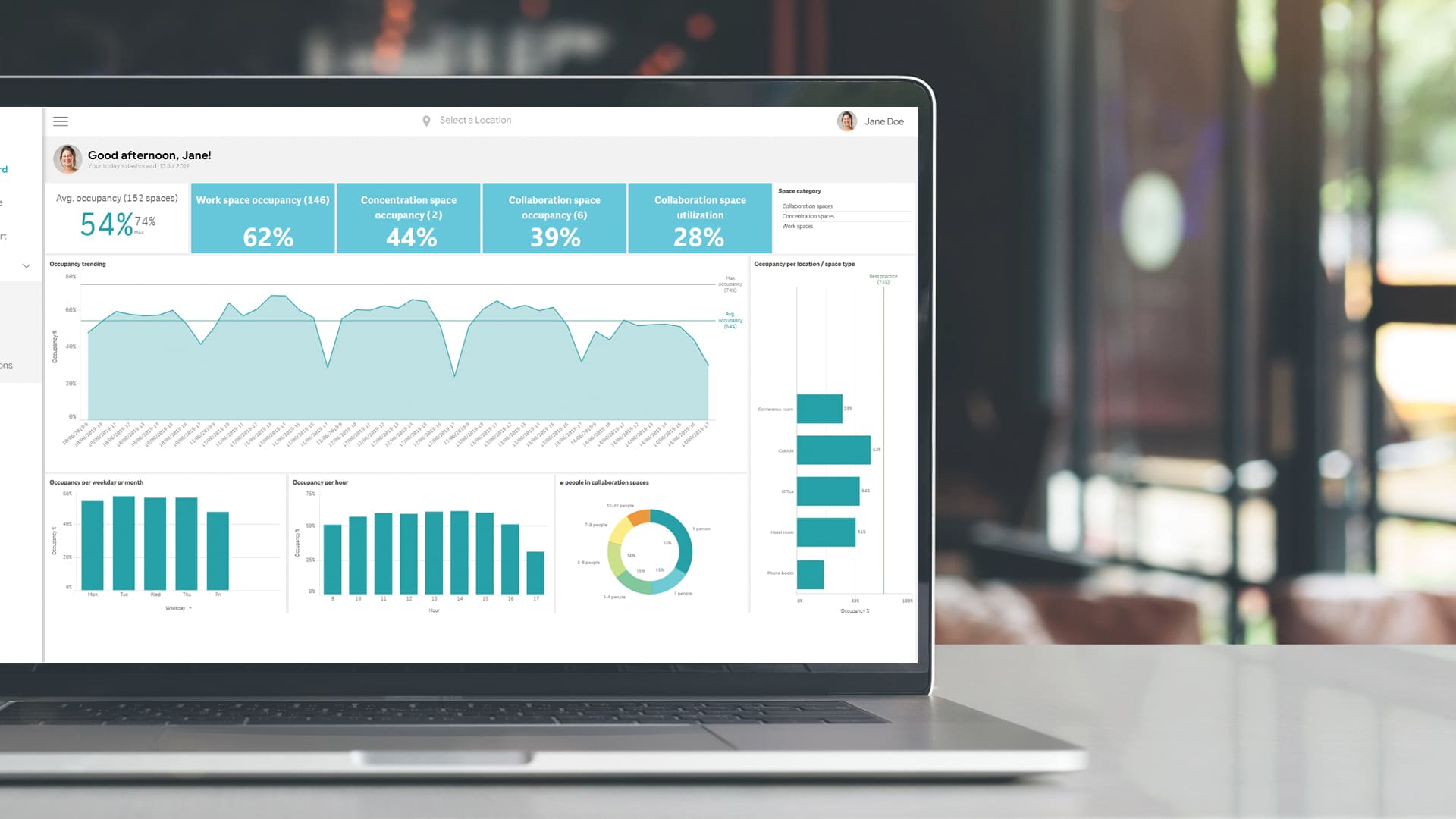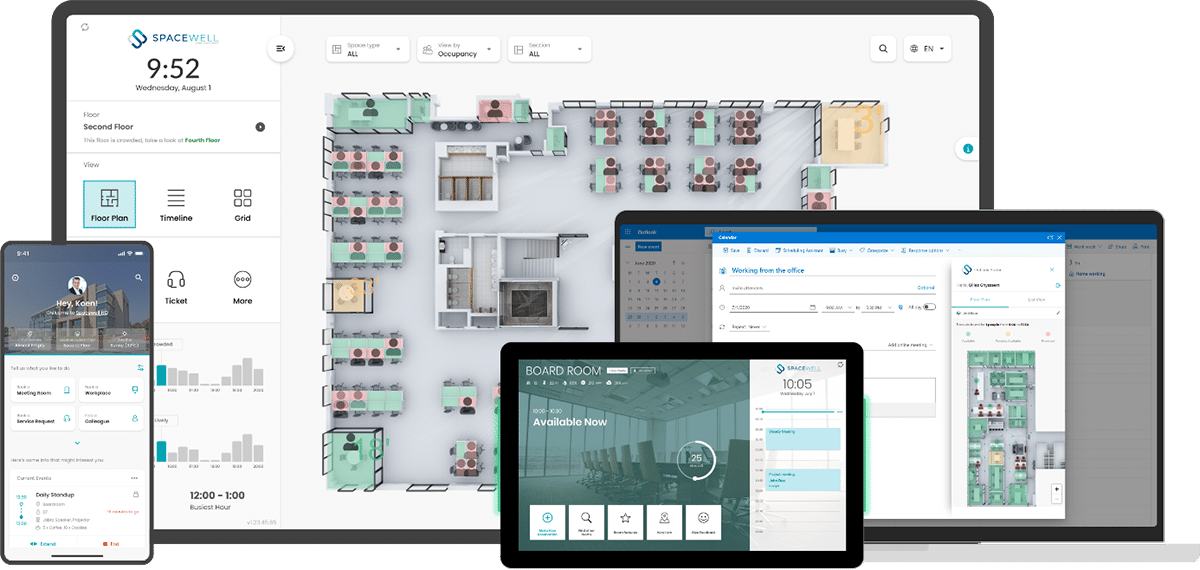The flex office is a rapidly developing workspace organization model that has many advantages, but also presents some disadvantages. Before implementing it, you should be aware of these and adopt the right tools to make the most of it.
What is the flex office?
Although the flex office – also known as activity-based office – is not new, its popularity has significantly increased since the Covid pandemic. So, what exactly is the flex office?
Flex office: definition
The term flex office refers to an organizational model in which workspaces are configured according to the needs of the workers. The objective is to offer conditions of comfort and ergonomics that optimize the well-being and productivity of employees.
The flex office in practice
In practice, employees no longer have assigned desks, but share the entire workspace. Depending on their activities, they choose a suitable space and register using their login details.
Flex space usually incorporates open office space with flexible seating, meeting and huddle rooms, quiet spaces, soundproof cubicles, and relaxation areas… And in a hybrid workplace model, employees can also work from home at least part of the time.
Read also: What are the key advantages of space management software?
Flexible office: advantages and disadvantages
Applying flex office principles generally benefits companies and their employees. However, it is important to understand the possible downsides, and to choose the right method and tools to put it into practice.
Advantages of the flex office
Here are some of the major advantages of implementing a flex office concept.
Flexibility
The flexibility of this mode of organization is an advantage in itself. Indeed, especially since the pandemic, employees may have different preferences in terms of working arrangements. While some prefer to work mostly from home, others prefer to alternate between working from home and the office, or to work mainly on site with their colleagues. Flexibility allows for everyone to choose what suits them best while still having access to their entire digital work environment.
Read also: Office Hoteling, Hot-Desking, Flexible Seating,… (Hybrid Office Series #2)
Limit routine
By removing assigned workstations, people will change places more regularly. This helps to fight against a routine often harmful to office life in the long term. Employees have more opportunities to meet new people or discover new environments, which encourages collaborative work and creativity.
Improve productivity
The freedom given to employees through a flexible organization helps boost their productivity. Indeed, in an activity-based environment, employees can choose the spaces best suited to the task at hand. They can find quiet spaces for focused work, work collaboratively in meeting and huddle rooms without disturbing other colleagues, or even telework.

Reduce travel time
Commuting time is often a significant problem for office workers, especially in large urban areas. By giving employees the opportunity to telework regularly, the flex office improves their quality of life. Hybrid work also helps to attract, retain, and engage much-needed talent.
Reduce real estate costs
Office spaces with flexible seating arrangements are more space-efficient. By matching the size of the office to the level of physical presence of employees, companies can reduce their office footprint, and make significant savings in rent, energy consumption, and services.
Optimize your square footage
Introducing a flex office concept in your company opens new perspectives in terms of space optimization. Since most employees alternate between their home office and the flex main office, the amount of office space required for the company’s operations is drastically reduced. This is an important source of savings for companies in the service sector where real estate is usually the second-highest expense, after payroll.
Disadvantages of the flex office
The application of flex office principles also brings possible disadvantages that should be well managed.
Logistics challenges
Ensuring efficient logistics in a flex office may pose problems if the company’s organization is not up to it. Keeping workspaces clean and functional, managing schedules, getting everyone to find a suitable place at any time is indeed a challenge in a flexible context. With poor organization, there is a risk that employees will not be able to perform their tasks in optimal conditions, or even resort to unwanted telecommuting.
The risk of depersonalization and disconnection
The absence of assigned desks or dedicated team spaces can generate a feeling of interchangeability or depersonalization among employees, negatively impacting their engagement. It is therefore important to make workspaces warm and friendly, and to maintain the quality of relationships within the company by providing moments of conviviality.
The fluidity of communication between colleagues must also be guaranteed despite the frequent absence of physical proximity between people in the same department.
The need for different management methods and communication
If management methods are not adapted to the flex office, the benefits of the latter can quickly disappear. Managers must ditch old-school thinking that focused on in-office presence and physically seeing their team at work. In an increasingly mobile and cloud-connected world, they should focus on outcomes and results instead. The organization will also have to rely on effective operational tools, such as a good internal communication system that is well understood by all employees.
Spacewell Workplace is a software solution designed for the flexible office
Thanks to Spacewell, companies can minimize the disadvantages of the flex office and make the most of this organization mode.
Reduce costs
In order to make the most of the potential for reducing costs related to workspaces, Spacewell office management software allows to monitor and analyze the evolution of occupancy rates, and to adapt the provision of spaces.

Adapt spaces to needs
In the same logic, Spacewell allows to identify occupancy patterns and preferred work areas, thanks to the data collected by sensors. This enables you to adapt workspaces to the needs of employees, in order to boost their performance and well-being.
Read also: Optimizing Office Space Configuration – Aligning Supply and Demand (Hybrid Office Series #4)
Manage equipment
In a flex office organization, keeping track of equipment and maintaining it can be complicated. With software like Spacewell Workplace (Watch an explainer video), companies can optimize maintenance interventions.
Provide a great workplace experience
Thanks to real-time sensor data, and digital floorplans on mobile tools, employees can easily navigate a flexible workplace environment. They can find and book free spaces without walking around, and can even check the temperature and air quality in meeting rooms.

Smarten operations
Workplace management software allows facility services to be in line with the actual building usage, thanks to the numerous data collected. This enables facility departments to be more efficient and reduce operating costs, while increasing occupant satisfaction.
Read also: Embracing Flexibility: Technology to Support Hybrid Work Environments
Organizing workspaces in flex office mode, if done right, has more advantages than disadvantages. By adopting software like Spacewell’s Workplace SaaS platform, companies can ensure a successful and beneficial implementation while reducing operating costs.






